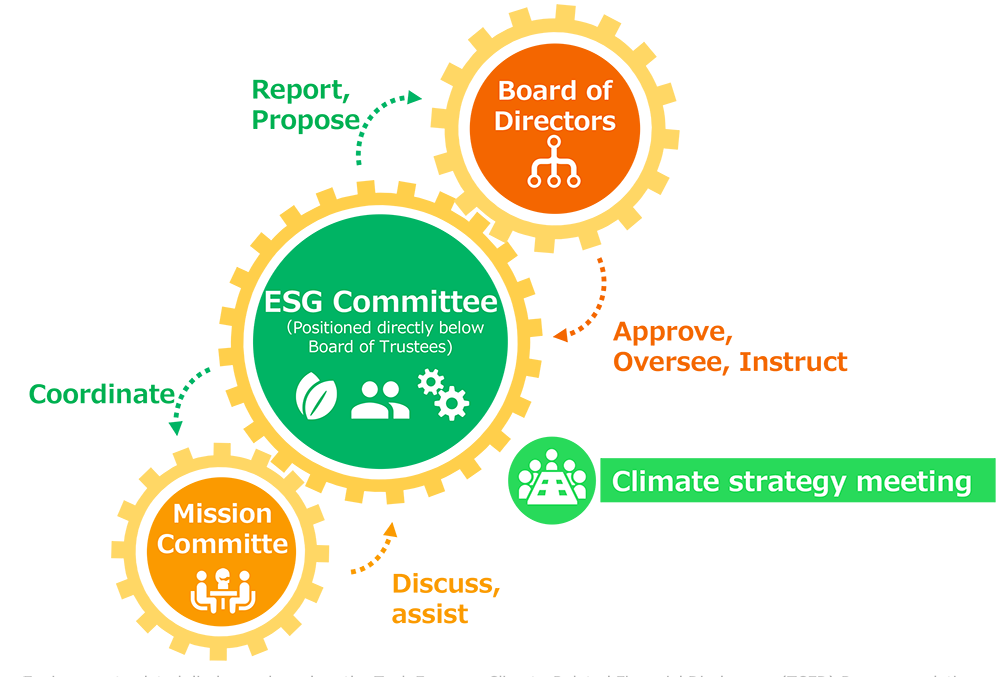IR Calendar
Environment
■E(Environment):Disclosure Based on TCFD Recommendations
| KPI | TCFD Scope/ Category |
FY 2021 | 2024 Target |
2030 Target |
|---|---|---|---|---|
| Emissions from company vehicles | Scope 1 | 11.0 t-CO2 | 10 t | 6 t |
| Emissions from consumption of purchased electricity (HQ, Sales Offices) | Scope 2 | 37.9 t-CO2 | 55 t | 65 t |
| Subtotal | Scope 1 + Scope 2 | 48.9 t-CO2 | 65 t | 71 t |
| Emissions from data centers not owned by the Company | Scope 3, Category 3 | 37.7 t-CO2 | 50 t | 65 t |
| Emissions from business travel | Scope 3, Category 6 | 86.6 t-CO2 | 100 t | 130 t |
| Emissions from employee commuting | Scope 3, Category 7 | 7.7 t-CO2 | 9 t | 10 t |
| Total (Scope 1 + Scope 2 + Scope 3) | Supply Chain GHG Emissions | 180.9 t-CO2 | 224 t | 276 t |
| Emissions Per System User | GHG intensity | 0.0012 t-CO2 / User | 0.0009 t | 0.0006 t |
※Overall CO2 emissions will increase due to server expansion, etc. stemming from business / user growth. However, Kanamic aims to halve emissions per system user by 2030.
ESG Material Topics (E):Harmony with the environment:TCFD-based disclosure
■The four thematic areas
TCFD has outlined 4 areas for companies to focus on when making disclosures regarding climate-related risks and opportunities.
As part of Kanamic’s overall ESG management strategy, the company announces its support of the TCFD recommendations and will endeavor to provide the following disclosures in line with them.
4 Thematic Areas
Kanamic will disclose its governance approach to climate related risks and opportunities.
Kanamic will disclose information on the impact of climate risks / opportunities on it’s strategy / business plans when this information is deemed important.
Kanamic will disclose how it identifies, evaluates, and manages climate-related risks.
Kanamic will disclose metrics / targets used in evaluating and managing climate related risk / opportunities when this information is deemed important.
■Oversight by the board of directors

ESG Committee
Propose metrics, targets and plans; and monitor progress of plans
- Identify environmental risk / opportunities
- Propose metrics (KPI) for evaluating environmental risk / opportunities
- Propose targets for managing environmental risk / opportunities
- Propose plans for achieving targets
- Monitor progress of plans, etc.
Mission Committee
Closely coordinate with the ESG Committee to implement plans and achieve targets
Board of Directors
Approve environment related targets / plans and oversee ESG Committee
- Identify environmental risk / opportunities
- Approve targets / plans
- Exercise oversight functions over ESG Committee
Climate strategy meeting
To better coordinate climate strategy, a regular joint meeting between the ESG Committee and the Mission Committee will be held once a year
■Enterprise Risk Management

Analyze the cost and impact of addressing each environmental risk and aim to smoothly incorporate countermeasures for specific environmental risks into overall management strategy.

Rather than only viewing climate related risks as merely a “source of risk to be mitigated,” instead also recognize that it may be appropriate to take certain risks to improve growth and profitability or to address other ESG material topics.

To facilitate this, the Company will conduct scenario analysis on a regular basis to predict and analyze the probability, impact, and nature of climate change-related risks identified under various environmental scenarios that may emerge in the future. Based on the results of this analysis, risks can be assigned priorities and the relative importance of various climate-related risks versus other risks (non-environmental risks) and opportunities can be assessed.
